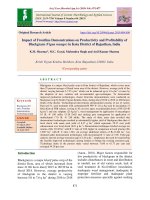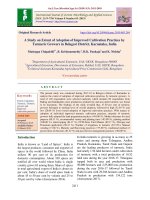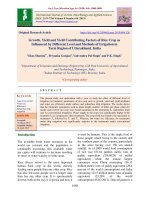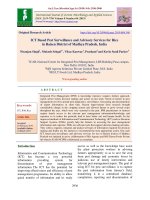Entrepreneurial behavior of rural youth engaged in vegetable cultivation in Lakhimpur district of Assam, India
Bạn đang xem bản rút gọn của tài liệu. Xem và tải ngay bản đầy đủ của tài liệu tại đây (203 KB, 6 trang )
Int.J.Curr.Microbiol.App.Sci (2018) 7(9): 1295-1300
International Journal of Current Microbiology and Applied Sciences
ISSN: 2319-7706 Volume 7 Number 09 (2018)
Journal homepage:
Original Research Article
/>
Entrepreneurial Behavior of Rural Youth Engaged in Vegetable
Cultivation in Lakhimpur District of Assam, India
Mouchumi Dutta*, Musliha Nasrin, Anurag Borthakur and Rajumoni Bordoloi
ICAR- Agricultural Technology Application Research Institute, Guwahati, India
*Corresponding author
ABSTRACT
Keywords
Rural youth, Vegetable
cultivation,
Entrepreneurial behaviour
Article Info
Accepted:
10 August 2018
Available Online:
10 September 2018
This study was undertaken in Lakhimpur district of Assam in the year 2017 with a view to
ascertain the entrepreneurial behaviour of rural youth engaged in vegetable cultivation.
The production of vegetables all around the year enables the growers to fully utilize their
resources and supplement income from vegetable growing as compared to other normal
agricultural crops. They provide an important source of income for the small and marginal
farmers of our country as well as upcoming rural youths. Effective extension intervention
may aid the process of intensification for full scale commercialization of production of
vegetable enterprises and promoting entrepreneurship and self-employment. For the study,
60 respondents were selected by purposive and random sampling technique. Data was
collected by administering a structured schedule. Statistical tools employed to analyze the
data included frequency distribution, percentage, mean, standard deviation. The study
revealed that more than half of the rural youth engaged in vegetable cultivation (61.67%)
had medium level of entrepreneurial behaviour in the district.
Introduction
Entrepreneurs are essential drivers of
innovation and progress. In the highly
competitive business world they act as engines
of growth, harnessing opportunity and
innovation to fuel economic advancement.
The world is facing a worsening youth
employment crisis as per the recent Report on
Youth 2013 released by International Labour
Organization (Anonymous, 2007). India
occupies only 2.2% of the world’s land area; it
supports over 15% of the world’s population.
Almost 35% of Indians are younger than 15
years of age (2011 census). Entrepreneurship
development is a major strategy that can
provide immediate large-scale employment.
Thus it helps to reduce the unemployment
problem in the country. Entrepreneurship
promotes balanced regional development.
Assam is traditionally rich in horticultural
production due to its diverse and unique agroclimatic conditions which is conducive for
growing wide range of horticultural crops like
fruits, vegetables, flowers etc. A horticultural
crop occupy about 15 per cent of the gross
cultivated area of Assam and annually
produces more than 15.0 lakh MT of fruits,
44.0 lakh MT of vegetables (Economic
Survey, Assam, 2011-12). There is a huge
potential for entrepreneurship development
through vegetable production.
1295
Int.J.Curr.Microbiol.App.Sci (2018) 7(9): 1295-1300
Therefore, a comprehensive study was carried
out to measure the entrepreneurial behavior of
rural youth engaged in vegetable cultivation.
The economy of Lakhimpur district is mainly
based on agriculture. 80% of the people of the
district depend solely on agriculture for their
livelihood. Total cropped area of this district is
2, 06,501 ha. Major crops are rice, tea,
mustard, sugarcane, etc. Vegetable cultivation
in Lakhimpur district has been traditionally
practised. Vegetables are playing an important
role in commerce and economy, particularly
through processing and export trade. They
provide an important source of income for the
small and marginal farmers of our country as
well as upcoming rural youths. Effective
extension intervention may aid the process of
intensification for full scale commercialization
of production of vegetable enterprises and
promoting
entrepreneurship
and
selfemployment. Therefore, it is assumed that the
present study will help in knowing the extent
of entrepreneurial behaviour of rural youth
engaged in vegetable cultivation and
harnessing
different
entrepreneurial
opportunities.
Materials and Methods
The study was conducted in Lakhimpur
district of Assam. A purposive cum random
sampling design was followed for selection of
respondents for the study. Under Lakhimpur
district 4 blocks namely Dhakuakhana,
Ghilamara, Lakhimpur and Karunabari were
purposively selected. One village from each
block were selected randomly. 15 respondents
from the total number of rural youths engaged
in vegetable cultivation were selected from
each of four villages by using random
sampling procedure. Thus, the total sample
size constituted 120 respondents (youth
between 15-29 years). The entrepreneurial
behaviour of vegetable grower was measured
in terms of nine dimensions namely,
innovativeness, achievement motivation,
decision making ability, risk orientation,
coordinating
ability,
planning
ability,
information
seeking
behaviour,
cosmopoliteness and self-confidence. To
measure the entrepreneurial behaviour of
vegetable
grower,
an
Entrepreneurial
Behaviour Index (EBI) was used with the help
of the following formula:
Scores obtained by each respondent
Actual total score
EBI =
× 100
Where, EBI = Entrepreneurial Behaviour
Index
Results and Discussion
Narmatha et al., (2002) stated that
innovativeness, achievement motivation and
risk orientation were the most important
components and further, decision making,
innovativeness, management orientation,
economic motivation, level of aspiration and
risk orientation were found to be crucial in
influencing the entrepreneurial behaviour.
Entrepreneurial behaviour is the composite
measure of nine components such as
innovativeness, achievement motivation,
decision making ability, risk orientation,
coordinating
ability,
planning
ability,
information
seeking
behaviour,
cosmopoliteness and self-confidence. Similar
observations were reported by Manjula
(1995). The data in this regard have been
presented in Table 1.
It could be observed from the Table 1 that,
71.67 per cent of rural youth engaged in
vegetable cultivation had medium level of
innovativeness, whereas 18.33 per cent and
10.00 per cent had low and high level of
innovativeness, respectively. Bhagyalaxmi et
al., (2003) reported similar kind of
observation in which majority of the
entrepreneurs had a medium level of
innovativeness.
1296
Int.J.Curr.Microbiol.App.Sci (2018) 7(9): 1295-1300
Table.1 Distribution of respondents according to the components of Entrepreneurial Behaviour
Dimension
Innovativeness
Achievement
motivation
Decision making
ability
Risk orientation
Co-ordinating
ability
Planning ability
Information
seeking
behaviour
Cosmopoliteness
Self confidence
Category
Low
Medium
High
Low
Medium
High
Poor
Moderate
Good
Low
Medium
High
Poor
Moderate
Good
Poor
Moderate
Good
Low
Medium
High
Low
Medium
High
Low
Medium
High
Lakhimpur (N = 60)
Score range
Below 6.26
6.26 to 11.10
Above 11.10
Below 3.50
3.50 to 4.93
Above 4.93
Below 8.30
8.30-11.09
Above 11.09
Below 6.30
6.30 to 8.49
Above 8.49
Below 4.07
4.07 to 6.86
Above 6.86
Below 2.02
2.02 to 3.44
Above 3.44
Below 6.18
6.18 to 9.75
Above 9.75
Below 7.13
7.13 to 9.06
Above 9.06
Below 4.11
4.11 to 5.61
Above 5.61
Frequency and percentage (%)
11 (18.33)
43 (71.67)
6(10.00)
10 (16.67)
27(45.00)
23 (38.33)
9 (15.00)
45 (75.00)
6(10.00)
15 (25.00)
34 (56.67)
11 (18.33)
17 (28.33)
37 (61.67)
6 (10.00)
23 (38.33)
29 (48.33)
8 (13.34)
12 (20.00)
35 (58.33)
13 (21.67)
10 (16.67)
49 (81.66)
1 (1.67)
13 (21.67)
38 (68.33)
9 (15.00)
Table.2 Distribution of respondents according to overall Entrepreneurial Behaviour N=60
Category
Low
Medium
High
Total
Mean = 49.73;
Score range
Below 45.52
45.52 to 53.93
Above 53.93
Frequency
13
37
10
60
S.D. = 4.20
1297
Percentage
21.67
61.66
16.67
100.00
Int.J.Curr.Microbiol.App.Sci (2018) 7(9): 1295-1300
Fig.1 Overall entrepreneurial behaviour
Based on this index, the respondents were classified in to three categories as given below:
Category
Low
Medium
High
Range
(X – SD)
(X ± SD)
(X + SD)
The scale developed by Chaudhari (2006) was used with slight modification.
The findings presented in the Table 1 shows
that, 45.00 per cent of rural youth engaged in
vegetable cultivation had medium level of
achievement motivation, followed by 38.33
per cent and 16.67 per cent have high and low
achievement
motivation
category
respectively. Suresh (2004) reported similar
kind of findings in case of achievement
motivation of dairy entrepreneurs.
It is apparent from the Table 1 that 75.00 per
cent of rural youth engaged in vegetable
enterprise had moderate decision making
ability; whereas 15.00 per cent belonged to
poor decision making ability and only 10.00
per cent have good decision making ability.
Chandrapaul (1998) reported similar kind of
findings in case of entrepreneurs of Andhra
Pradesh in which majority of entrepreneurs
(50.90%) had medium decision making
ability. From the Table 1 it was found that
56.67 per cent of rural youth engaged in
vegetable enterprise had medium risk
orientation, whereas 25.00 per cent belonged
to low risk orientation and only 18.33 per cent
have high risk orientation (Fig. 1).
It could be inferred from Table 1 that 61.67
per cent of rural youth engaged in vegetable
cultivation had moderate co-ordinating ability
and 10.00 per cent was found in good and
28.33 per cent poor category of co-ordinating
ability.
It is evident from the Table 1 that 48.33 per
cent of rural youth engaged in vegetable
cultivation had moderate planning ability,
followed by poor (38.33%) and good
(13.34%) respectively.
1298
Int.J.Curr.Microbiol.App.Sci (2018) 7(9): 1295-1300
The results from Table 1 revealed that
majority (58.33%) of rural youth (vegetable
growers) had medium information seeking
behaviour, followed by high (21.67%) and
low (20.00%) information seeking behaviour.
It could be seen from the Table 1 that more
than half (81.66%) of rural youth (vegetable
growers)
had
medium
level
of
cosmopoliteness, followed by low (16.67%)
and high (1.67%) level of cosmopoliteness.
Similar kinds of findings were observed by
Patel et al., [7] where majority (74.00%) of
the entrepreneurs had medium level of
cosmopoliteness.
It is quite clear from the data presented in the
Table 1 that (63.33%) of rural youth engaged
in vegetable cultivation had medium level of
self-confidence, followed by low (21.67%)
and high (15.00%) level of self-confidence.
Entrepreneurial Behaviour Index (EBI) was
used to measure the entrepreneurial behaviour
of rural youth engaged in vegetable
cultivation by considering the scores obtained
by each respondent and actual total score. The
data in this regard have been presented in
Table 2. A critical perusal of the data
furnished in Table 2 portrays that more than
half of the rural youth engaged in vegetable
cultivation (61.66%) had medium level of
entrepreneurial behaviour, followed by
(21.67%) of low and (16.67%) of high
entrepreneurial behaviour.
It may be concluded that most of the rural
youth engaged in vegetable cultivation were
found to have a medium level of
entrepreneurial behaviour (61.66%). The
findings of the present study have a number
of implications for the administrators and
policy
makers.
Effective
extension
intervention may aid the process of
intensification
for
full-scale
commercialization of vegetable production by
facilitating adoption of recommended
package of practices and promoting
entrepreneurship and self-employment. It also
helps in taking policy measures for
identification of thrust areas and in designing
new strategies for vegetable production in the
country. Concerned departments or agencies
like State Horticultural Departments, KVKs,
NABARD, NIRD, IIE should organise
appropriate training programme for the
vegetable grower to inculcate better decision
making ability and self- confidence so that
they are motivated to accept it as enterprise.
References
Anonymous (2007). ILO publication. Youth
in Crisis; Coming of Age in the 21st
Century.
Anonymous (2011-12). Economic Survey,
Assam. Retrieved from the website:
/>mic_survey2011-12.pdf.
Bhagyalaxmi, K., Gopalakrishna Rao, V. and
Sudarshanreddy, M. (2003). Profile of
the rural women micro entrepreneurs. J.
Res. 31(4): 51-54.
Chandrapaul, K. (1998). A study on
entrepreneurial behaviour of vegetable
growers in Krishna district of Andhra
Pradesh. M.Sc. (Agri.) Thesis, Acharya
N. G. Ranga Agricultural University,
Hyderabad.
Chaudhari, R. R. (2006). A study on
entrepreneurial behaviour of dairy
farmers. Ph.D. Thesis, University of
Agricultural Science, Dharwad.
Manjula, S. (1995). A study on
entrepreneurial behaviour of rural
women in Ranga Reddy District of
Andhra
Pradesh.
M.Sc.
Thesis,
ANGRAU, Rajendra Nagar, Hyderabad.
Narmatha, N., Krishnaraj, R. and Mohmed,
Safiullah, A. (2002).Entrepreneurship
behaviour of livestock farm women. J.
Extn. Edu. 13(4): 3431-3438.
1299
Int.J.Curr.Microbiol.App.Sci (2018) 7(9): 1295-1300
Suresh, (2004). Entrepreneurial behaviour of
milk producers in Chittoor district of
Andhra Pradesh: A critical study.
M.V.Sc. Thesis, Acharya N. G. Ranga
Agricultural University, Hyderabad.
How to cite this article:
Mouchumi Dutta, Musliha Nasrin, Anurag Borthakur and Rajumoni Bordoloi. 2018.
Entrepreneurial Behavior of Rural Youth Engaged in Vegetable Cultivation in Lakhimpur
District of Assam, India. Int.J.Curr.Microbiol.App.Sci. 7(09): 1295-1300.
doi: />
1300









